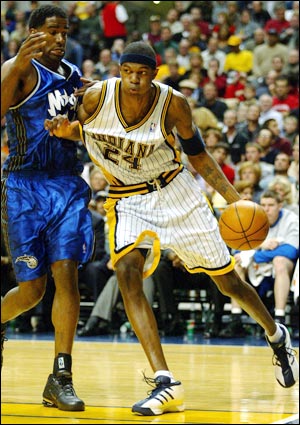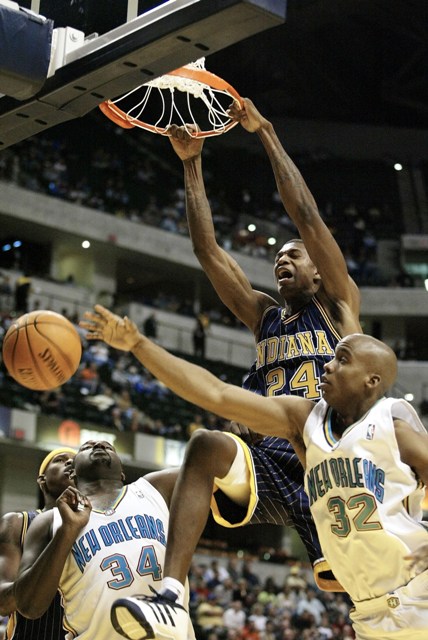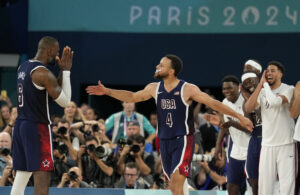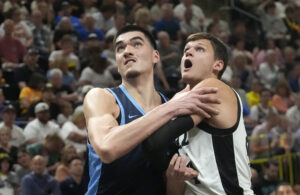- Attacking style not the only reason some Tottenham fans will back Ange Postecoglou until the bitter endPosted 4 months ago
- Paris Olympics takeaways: What did Team USA’s crunch-time lineup say about NBA’s hierarchy?Posted 10 months ago
- Zach Edey posted an easy double-double in Summer League debut. Here’s why he’ll succeed in NBAPosted 11 months ago
- What will we most remember these champion Boston Celtics for?Posted 11 months ago
- After long, seven-year road filled with excruciating losses, Celtics’ coast to NBA title felt ‘surreal’Posted 12 months ago
- South Florida men’s basketball is on an unbelievable heater– but also still on the bubblePosted 1 year ago
- Kobe Bufkin is balling out for Atlanta Hawks’ G League team. When will he be called up to NBA?Posted 1 year ago
- Former Knicks guards Immanuel Quickley, RJ Barrett may yet prove Raptors won the OG Anunoby tradePosted 1 year ago
- Rebounding savant Oscar Tshiebwe finally gets NBA chance he’s deserved for yearsPosted 1 year ago
- Is Tyrese Maxey vs. Tyrese Haliburton the next great NBA guard rivalry?Posted 2 years ago
Former preps-to-pros star Jonathan Bender is now a successful inventor
- Updated: August 1, 2013
If you remember Jonathan Bender at all, you probably think of him as one of those high school prodigies who never went to college.
Selected with the No. 5 pick in the 1999 NBA Draft, the lanky 7-foot teenager was destined to become the future of the Indiana Pacers, that weight to be slung on his shoulders in the post-Reggie Miller era.
You might remember the promise Bender once had; the guard-like quickness with which he moved his 7-foot frame, or how he could explode to the basket and throw down some of the prettiest-looking dunks you’ve ever seen. His wingspan would have made Jay Bilas blush, his perimeter game a primitive-age predecessor to Kevin Durant.
You probably don’t remember much about him on the court in the NBA, as he flamed out in just seven seasons, falling victim to a massive knee injury that virtually ended his career. And that’s probably where you forgot about Jonathan Bender, his story blending into the common narrative about high schoolers coming out too early, blowing their fortunes and ending up vagabonds in the basketball economy.
With no college education and a poverty-stricken upbringing, you might think Bender ended up like Darius Miles, a former high school star who fell into bankruptcy.
You probably think his story is a sad one, a cautionary tale you’d tell your kids about the value of an education.
But you’d be wrong.
Jonathan Bender is a self-made millionaire.
And he didn’t do it with his basketball skills. He did it with his brain.
There he was, sitting on a park bench in Houston just months after nagging knee injuries had finally forced him to call it a career, watching people walk by and wondering what might have been if things had turned out differently.
“The sky was the limit,” Bender said of his career, though there’s no trace of lament in his voice.
His time in the NBA started out well, as he became the only high schooler to score in double figures in his first game (10 points in 13 minutes). But he came along slowly, averaging minuscule minutes in his first two years before emerging as a solid contributor in 2002, putting up 8 points in 21 minutes per game. Bender signed a four-year, $28.5 million contract extension that offseason, and he figured to fit squarely into the Pacers’ plans going forward.
But that’s when his knees gave in. A major knee injury sidelined him for half of the 2003 season, and he was never the same, playing in just 30 games in the next three years. He retired following the 2006 season, a washout and a bust in the eyes of Pacers fans who had hoped he’d become the NBA’s next teenage star.
He wound up on that bench in Houston just months later. Though he was deep in thought on that particular afternoon, Bender wasn’t at any movie-like crossroads or stuck in the middle of a quarter-life crisis.
Unlike the stereotypical professional athlete (“we’ve been raised not to really use our brains,” he says), Bender had always been a deep thinker. He remembers an epiphany he had while sitting on another bench, at the Pacers game in 2005. He looked over at then-owner Mel Simon, in one of the few games the billionaire attended, and started to wonder how the mall construction magnate had gotten there.
“Those guys,” Bender says, speaking of NBA owners, “I always thought owning the team was their big business. But when I did some investigating, I realized this was just a side thing to them. It was like their board game,” he said.
He drove past Simon’s house and marveled at the way the billionaire lived. “He had an 18-hole golf course in his front yard,” Bender recalls. “I was just amazed at how this guy functioned.”
So, he did some research, reading about Andrew Carnegie and J.P. Morgan and the like. “I wanted to get into their mentality,” Bender said.
He never got the chance to ask Simon for any first-hand advice, because, as he said, ” it’s a stereotype. They look at us like, we’re working for one of their little side companies.”
So instead, he came up with a financial plan for his future.
He decided to take control of his finances himself because, “It was either let a financial guy go out and gamble my money and I would sit back at home with my fingers and toes crossed hoping he doesn’t lose it, or I go out and gamble and at least if I lose my money, I learn a lesson, not him,” he said.
He tried his hand at real estate and the music business, and ended up losing–er–learning a lot of lessons. He was doing well overall, but nothing seemed to click until that afternoon on the park bench in Houston, where the rest of his life changed.
With Bender, every experience serves as a lesson.
All of that time he spent lying on a training table trying to rehab his knee had been tantamount to an advanced degree in physical therapy. He soaked in all of the knowledge from his trainers, including renowned physician Dr. Dan Dyrek, who had worked on various baseball stars and Pacers executive Larry Bird during his playing days.
“I just soaked up everything they told me,” Bender said.
“I learned about muscle engagement, and which muscles needed to be activated to protect certain joints, and with me being naturally creative, it was easy for me to translate a lot of that.”
As he sat on the park bench that afternoon, Bender focused on the way people moved, and how they shifted their weight to keep balance.
All of a sudden, it hit him.
“I thought if you added a band to the back of their leg, I didn’t know exactly what it would do, but I knew it would add some resistance,” he said.
So he rushed into CVS and bought some duct tape and office binder clips, then ran up to his apartment to put together a contraption of ankle weights and rubber bands, and in no more than 10 minutes, he had what he described as sort of an external hamstring.
He brought his invention to physicians at Purdue University, and they were amazed with what he had come up with. “It worked well,” Bender said. “But it looked like crap.”
So, he did some research and found out how to go about getting a product manufactured and brought into market. He hired a marketing guy, and struck a deal with a manufacturer in China. The entire process took him six years.
“It was the toughest thing I’ve ever done in my life, tougher than going to the NBA,” Bender said.
Today, the JB Intensive Trainer sells for $130 on his website. It’s been a popular buy among fitness and physical therapy gurus, who praise the product as innovative.
Most people wouldn’t expect this kind of ingenuity from a big-time athlete who never went to college, but for Bender, this is par for the course.
“As athletes, we don’t really get the chance to use our brains within life until we retire,” he said. Bender would return to the NBA in 2010 for a brief cameo with the Knicks before permanently calling it a career to focus on his business. He said part of the reason for his comeback was to prove to himself that his product worked.
“God gave me a brain and some creativity,” he said.
And Jonathan Bender did the rest.
Also see: Our night with the head of NCAA basketball officials, John Adams






